现代英语词汇学概论3 word-formation
- 格式:ppt
- 大小:889.00 KB
- 文档页数:3
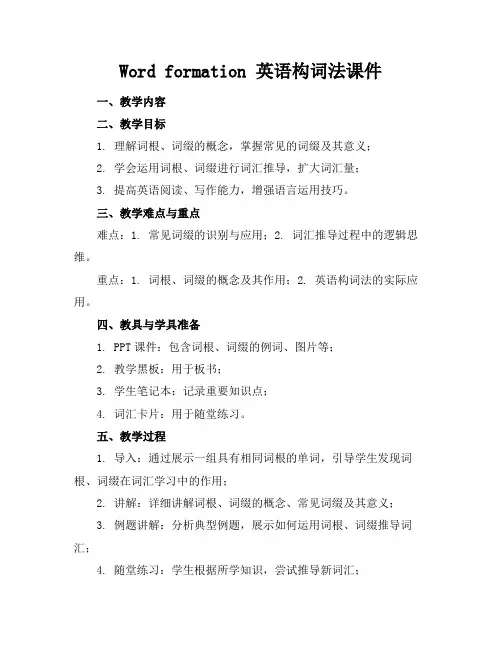
Word formation 英语构词法课件一、教学内容二、教学目标1. 理解词根、词缀的概念,掌握常见的词缀及其意义;2. 学会运用词根、词缀进行词汇推导,扩大词汇量;3. 提高英语阅读、写作能力,增强语言运用技巧。
三、教学难点与重点难点:1. 常见词缀的识别与应用;2. 词汇推导过程中的逻辑思维。
重点:1. 词根、词缀的概念及其作用;2. 英语构词法的实际应用。
四、教具与学具准备1. PPT课件:包含词根、词缀的例词、图片等;2. 教学黑板:用于板书;3. 学生笔记本:记录重要知识点;4. 词汇卡片:用于随堂练习。
五、教学过程1. 导入:通过展示一组具有相同词根的单词,引导学生发现词根、词缀在词汇学习中的作用;2. 讲解:详细讲解词根、词缀的概念、常见词缀及其意义;3. 例题讲解:分析典型例题,展示如何运用词根、词缀推导词汇;4. 随堂练习:学生根据所学知识,尝试推导新词汇;6. 作业布置:布置课后作业,巩固所学知识。
六、板书设计1. 板书Word Formation English wordbuilding methods2. 主要内容:词根、词缀的概念;常见前缀、后缀及其意义;词汇推导方法;实例展示。
七、作业设计1. 作业题目:b. 根据所学词根、词缀,推导出5个新词汇,并给出简要解释。
2. 答案:Happy → Unhappy(前缀“un”表示否定)Do → Undo(前缀“un”表示否定)Bind → Unbind(前缀“un”表示否定)Cover → Uncover(前缀“un”表示否定)八、课后反思及拓展延伸拓展延伸:引导学生关注其他语言中的构词法,如法语、德语等,了解不同语言之间的构词特点,提高跨文化交际能力。
重点和难点解析1. 教学难点与重点的识别;2. 教学过程中的例题讲解;3. 作业设计中的词汇推导;4. 课后反思及拓展延伸的实践应用。
一、教学难点与重点的识别在英语构词法的教学中,识别并明确难点和重点是至关重要的。
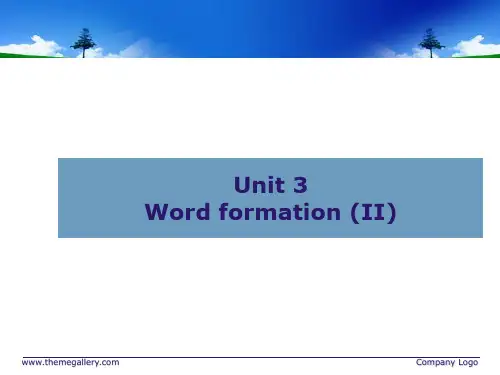
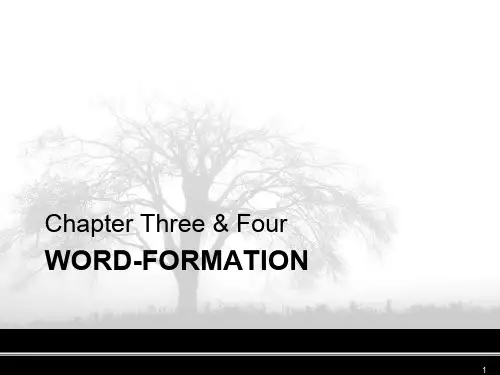
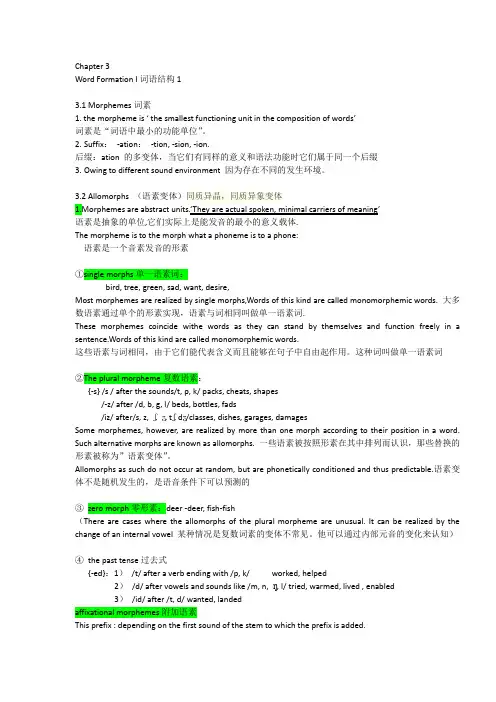
Chapter 3Word Formation I词语结构13.1 Morphemes词素1. the morpheme is ‘ the smallest functioning unit in the composition of words’词素是“词语中最小的功能单位”。
2.Suffix:-ation:-tion, -sion, -ion.后缀:ation 的多变体,当它们有同样的意义和语法功能时它们属于同一个后缀3.Owing to different sound environment 因为存在不同的发生环境。
3.2 Allomorphs (语素变体)同质异晶,同质异象变体1.Morphemes are abstract units.‘They are actual spoken, minimal carriers of meaning’语素是抽象的单位,它们实际上是能发音的最小的意义载体.The morpheme is to the morph what a phoneme is to a phone:语素是一个音素发音的形素①single morphs单一语素词:bird, tree, green, sad, want, desire,Most morphemes are realized by single morphs,Words of this kind are called monomorphemic words.大多数语素通过单个的形素实现,语素与词相同叫做单一语素词.These morphemes coincide withe words as they can stand by themselves and function freely in a sentence.Words of this kind are called monomorphemic words.这些语素与词相同,由于它们能代表含义而且能够在句子中自由起作用。
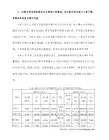
Word-FormationAbstract : A further way besides borrowing in which the vocabulary of English has expanded to accommodate to the natural and social world in which it is used has been to employ means internal to the language itself for devising new word. This is the area of word-formation. Morphological productivity can be defined as the property of a given word formation process to be used to derive a new word in a systematic fashion. Most linguists divide the word-formation into major word-formation and minor word-formation .The major word-formational processes are :-Affixation-Compounding-ConversionThe minor word-formational processes are :-Abbreviation-Back formation-OnomatopoeiaKey Word : affixation, derivative, compounding, abbreviation, onomatopoeia1 AffixationAffixation, also called derivation, is a process in which a free morph is combined with a bound morph, a prefix, or a suffix. It is generally defined as the formation of words by adding derivational affixes to different types of bases . There are two types of derivative . One bases on free root with affix or bound root , the other bases on bound with affix or other bound root .1.1 Types of affixes- prefixes- suffixes- infixesModern English has a number of highly productive affixes. For example, the prefix over can be added to verbs which express activities to indicate that too much has taken place, i.e. something has been overdone, cf. overcook, overcoat, overstay. Likewise, the suffix –n ess can be added to an adjective make a noun designating the quality express by the adjective, its nouniness, so to speak.1.2Two types of derivative’s structure1.2.1 Free root + affix/bound root1) prefix + free roote.g.: In definite (a. uncertain), un forgettable (a. memorable) , mini bus (coach)2)free + suffixe.g. : wealth y (a. rich) , success ful (a, achieving aims) , extreme ly(adv, to a very high de.g.ree) , comfortab ly(adv. in a comfortableway)3)prefix +free root + suffixe.g. : en rich ment (a. sb/sth being rich or richer) , in ternation al (a.connected with two or more countries) , unchangeable (a. that can notbe changed)4)combining form + free roote.g. Afro-American , Afro-Asian , techno-chemistry , microwave1.2.2Bound root + affix/bound root1)prefix + bound root (without formation)e.g. contradict (v. to say sb has said is wrong) , descend (v. go down) ,despair (v. give up all hope)2)bound root (without formation)+ suffixe.g. confidence (n. trust in) , liberate (v. emancipation) , linguist (n. aperson who knows several foreign languages well)3)prefix + bound root (without formation)e.g. distinctive (a. special ) , intolerable (a. can’t bear) , contradiction(n. a lack of agreement between facts)24)combining form + combining forme.g. macrobiosis (n. long life) , microscope (n. an instrument used inscientific study for making very small thing look larger)2CompoundingComposition or compounding is a word-formation process consisting of joining two or more bases to form a new unit, that is, a compound. Compounding is perhaps the most common way of expanding the vocabulary of English. It allows users to combine two familiar words to form a new lexeme.Very often compounds are written as two words, which means that they are accepted into dictionaries a little reluctantly. Certainly, dictionaries seem not to list compounds in anything like the numbers in which they are in use. This may be justified perhaps because compounds are frequently transparent and their meanings are relatively accessible without a dictionary. Furthermore, many of them do not become lexicalized, but have a very transitory life.According to the words’characteristic, there are compound nouns, compound adjectives , compound pronouns , compound verbs , compound adverbs , etc .2.1Compound Nounsn. + n.: bar code , mouse mat , Websitea. + n.: blueprint , compact discadv. + n.: off chance , overdose , underclothes-ing + n.: learning strate.g.y , marketing campaign , parking metern. + v.: daybreak , earthquake , parking meteradv + n : downfall , income , offset , output , upliftv. + adv.: get-together , handout , makeupn. + -ing: air-conditioning , brainstorming , family planningprep.+n.: afternoon , by-product , overcoat2.2Compound AdjectivesAs adjective is a core : airsick , band-new ; dark-blue , icy-cold ;3all-mighty , evergreen , overripeAs noun is a core : blue-collar , present-day ; breaknecl , cross-country ;chicken-hearted , dog-eared , wine-coloredAs –ing or –ed is a core : energy-saving , epoch-marking ; easy-going ,far-reaching ; mass-produced , poverty-stricken ; absent-minded ,half-done , newly-built2.3Compound Verbs1)Formed by back-formation : house-keep from housekeeperwindowshop from window-shoppinghenpeck from henpecked2)Formed by conversion : to blue-printto cold-shoulderto honeymoon3) adv. + v. : cross-questionoffsetoverthrow3ConversionConversion is a word-formation whereby a word of a certain word-class is shifted into a word of another without the addition of an affix. It is also called zero derivation. In other words, conversion or zero derivation is a type word class change without the addition, removal ,or change of any element in the word. In this process a noun maybe used as a verb or a verb can be used as a noun. Furthermore, a noun can be used attributively as an adjective. The most frequent type of conversion is from noun to verb, probably because there are so relatively few verbalizing affixes in English.3.1 n.→ v.1)to put in/on, such as, bottle(n.)→to bottle(=to put …into a bottle)2)to give, to provide with, such as, butter(n.) →to butter(=to spread butteron)3)to deprive of, such as, skin(n.) →to skin(=to remove the skin from)44)to…with, such as, hammer(n.) →to hammer(=to strike with a hammer)5)to be/act as …with respect to, such as, ape(n) →to ape(=to imitate like aape)6)to make/change…into, such as, fool(n.) →to fool(=to make a fool of)7)to send…/go by, such as, bicycle(n.) →to bicycle(=to go by bicycle)3.2adj.→ v.bare(adj.) →to bare, calm(adj.) →to clam, brave(adj.) →to brave3.3v.→ n.Verb converting into noun express the verb’s original action or condition mostly, such as, attempt, look, swim, smile, walk, etc.3.4adj.→ n.Most adjective can be used as noun, such as, an American, an Canadian,etc. There are three type of conversion, full conversion, partial conversionand special conversion.3.5n.→ adj.a brick garage (The garage is brick.)a cotton dress (The dress is cotton.)a gold watch, an iron box, the job market4ShorteningAbbreviation or shortening is the way of shortening or simplifying syllables to make new words. There are various forms of abbreviation, but main forms are four: clipped word, initialism, acronym, blend.4.1 ClippingsSpeakers of English have a great tendency to shorten words. This term refers to the process by which a word of two or more syllables is shortened without a change in its function taking place. It includes apocope, aphaeresis, front and back clipping, and syncope.1) Apocopeapprox.← approximately, auto← automobile52) Aphaeresisburger→ hamburger, bus→ omnibus3) Front and back clippingsThe shortening may occur at the start and the end of the word. e.g., flu(=influenza) / fridge(=refrigerator) / tec(=detective)4) Syncopefluidics← fluidonics, fossilation← fossilizationContractions which is the clipping word with punctuation also can be regarded as this type.4.2 Initialisms and AcronymsInitialisms are words from the initial letters of words which are pronounced as sequences of letters e.g., EEC. Acronyms are also formed from the initial letters of words, but are pronounced as a word, e.g. radar(radio detecting and ranging). Acronyms have always been an integral part of computer culture, and they have since spawned a new language on the Internet. Commonly thought of as a series of letters that make up a “word” there is a distinction between acronyms and shorthand.4.3BlendsBlends are words formed by combining the first element of the first word and the last element of the second word. Blends are created originally for comic effect. Following are some examples:Chunnel(=channel + tunnel) / brunch(=breakfast + lunch) / motel(=motorist+hotel)5Back-formationBack-formation is the process of word-building by which elements are subtracted from a complex word.e.g. beggar---beg burglar---burgleThe majority of backformed words are verbs. There are two types of syntactic relation in verb compounds formed by backformation:1)Object + verb as sightsee (from sight-seeing) meaning somebody sees6sights. Similar examples are: globe-trot(from globe-trotter orglobe-trotting).2)Adverbial + verb, as spring-clean (from spring-cleaning) meaningsomebody cleans in the spring.Back-formations of all kinds are more frequently found in informal than in formal language.6OnomatopoeiaOnomatopoeia is a word-formation which imitate the sound. Imitative words are words formed by imitation of sound. Imitative words divide into primary onomatopoeia and secondary onomatopoeia.The barking of a dog.The crack of a whip.The roll of thunder.The tinkling of bells.There are three types of words formed by imitation of sound:1)The repetition of words: quack; ticktack2)The repetition of words with a vowel change: clitter-clatter; ping-pong;tick-tack.3)Repeating one or more syllables with a consonant change : rub-a-dubt;ran-danReference: Wang Rongpei, Wang Zhijiang, An Advanced Reader of English Lexicology, Shanghai Foreign Language Education Press, 2006汪榕培,王之江,《英语词汇学》,上海外语教育出版社,2008789。
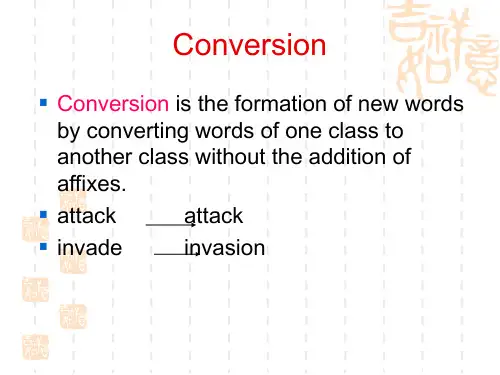
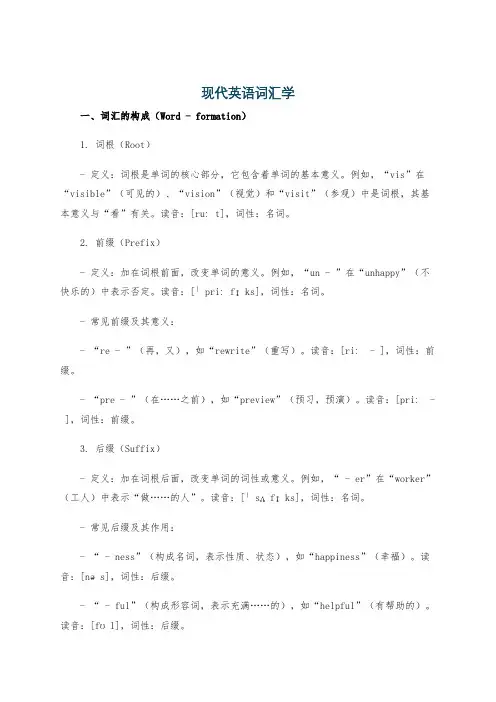
现代英语词汇学一、词汇的构成(Word - formation)1. 词根(Root)- 定义:词根是单词的核心部分,它包含着单词的基本意义。
例如,“vis”在“visible”(可见的)、“vision”(视觉)和“visit”(参观)中是词根,其基本意义与“看”有关。
读音:[ruːt],词性:名词。
2. 前缀(Prefix)- 定义:加在词根前面,改变单词的意义。
例如,“un - ”在“unhappy”(不快乐的)中表示否定。
读音:[ˈpriːfɪks],词性:名词。
- 常见前缀及其意义:- “re - ”(再,又),如“rewrite”(重写)。
读音:[riː - ],词性:前缀。
- “pre - ”(在……之前),如“preview”(预习,预演)。
读音:[priː - ],词性:前缀。
3. 后缀(Suffix)- 定义:加在词根后面,改变单词的词性或意义。
例如,“ - er”在“worker”(工人)中表示“做……的人”。
读音:[ˈsʌfɪks],词性:名词。
- 常见后缀及其作用:- “ - ness”(构成名词,表示性质、状态),如“happiness”(幸福)。
读音:[nəs],词性:后缀。
- “ - ful”(构成形容词,表示充满……的),如“helpful”(有帮助的)。
读音:[fʊl],词性:后缀。
二、词性(Parts of Speech)1. 名词(Noun)- 定义:表示人、事物、地点、抽象概念等。
例如,“book”(书)、“city”(城市)、“love”(爱)。
读音:[naʊn],词性:名词。
- 名词的分类:- 可数名词(Countable Noun),如“apple”(苹果),有单复数形式。
- 不可数名词(Uncountable Noun),如“water”(水),一般没有复数形式。
2. 动词(Verb)- 定义:表示动作或状态。
例如,“run”(跑)、“be”(是)。
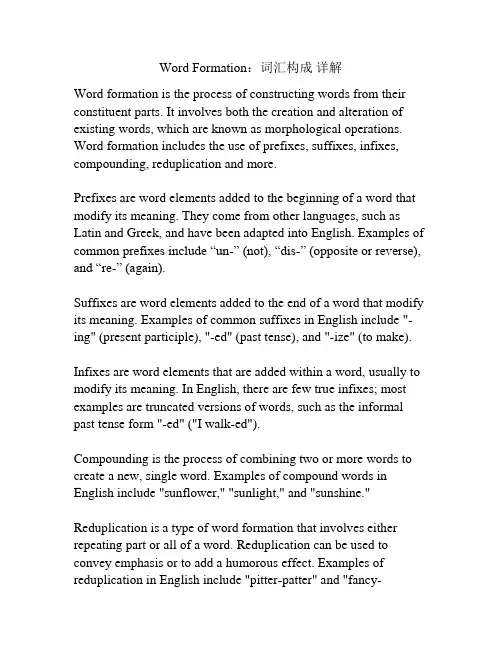
Word Formation:词汇构成详解Word formation is the process of constructing words from their constituent parts. It involves both the creation and alteration of existing words, which are known as morphological operations. Word formation includes the use of prefixes, suffixes, infixes, compounding, reduplication and more.Prefixes are word elements added to the beginning of a word that modify its meaning. They come from other languages, such as Latin and Greek, and have been adapted into English. Examples of common prefixes include “un-” (not), “dis-” (opposite or reverse), and “re-” (again).Suffixes are word elements added to the end of a word that modify its meaning. Examples of common suffixes in English include "-ing" (present participle), "-ed" (past tense), and "-ize" (to make).Infixes are word elements that are added within a word, usually to modify its meaning. In English, there are few true infixes; most examples are truncated versions of words, such as the informal past tense form "-ed" ("I walk-ed").Compounding is the process of combining two or more words to create a new, single word. Examples of compound words in English include "sunflower," "sunlight," and "sunshine." Reduplication is a type of word formation that involves either repeating part or all of a word. Reduplication can be used to convey emphasis or to add a humorous effect. Examples of reduplication in English include "pitter-patter" and "fancy-shmancy."Blending is another type of word formation in which two words are combined to create a new one. Commonly used blends include "chillax" (chill+relax) and "bromance" (brother+romance).Clipping is a type of word formation in which part of a word is removed. This is done to create a shorter version of the word, often for convenience or to reduce ambiguity. Examples of clipped words used in English include "fridge" (refrigerator) and "fax" (facsimile).Back-formation is a process of word formation in which a “new” word is created by removing a suffix from an existing word. Often the resulting word has a different meaning than the original. Examples of back-formation in English include "edit" (from editor) and "burgle" (from burglar).Conversion is a type of word formation in which a word changes its part of speech without any changes to its spelling or pronunciation. It involves taking a verb or noun and turning it into an adjective or adverb. Examples of conversion in English include "careless" (from "to care"), "homely" (from "home"), and "slowly" (from "slow").Word formation is an important part of language, as it allows us to expand our vocabulary and communicate more effectively. By understanding the various processes involved in word formation, we can communicate more accurately and clearly.。



张韵斐著《现代英语词汇学概论》——解析第一部分Chapter Ⅰ英语词汇得概论(Ageneralsurvey ofEnglish vocabu lary)Bloomfield1933中对词得定义就是,每个单词都就是最小得自由词.然而这个定义不够全面,存在着缺陷。
首先,不就是所有得单词都可以独立出现,如the ,a ,my 这些单词单独出现则没有具体意义.另外,Bloomfield得定义侧重在于语法(syntax)却没有涉及到词得意义。
随着词汇学得发展跟完善,人们给词下了较为完整得定义.“词,今指语言组织中得基础单位,能独立运用,具有声音、意义与语法功能。
”(《辞海》1984(上)375页,上海辞书出版社)一种语言中所有得单词汇集起来便构成了该语言得词库。
纵观英语得发展历史,我们可以知道,大多数得英语词汇都就是外来词,它从拉丁语,法语与希腊语等语言中汲取词汇,不断得扩充自己,为己所用.特别就是第二次世界大战之后,英语词汇得到了空前得发展。
现代英语词汇快速发展得原因主要有四方面。
一就是科学技术得快速发展,二就是社会经济得全球化,三就是英语国家得政治与文化变化,最后就是其她文化与语言对英语得强烈影响。
英语词汇就是由各种不同类型得单词组成,而这些单词有着不同得分类标准。
根据词得起源可以分为本族语与外来语;根据使用水平可以分为普通词汇,文学词汇。
口头词汇,俚语以及科学术语.基础语库得基本特征就是具有民族特征,稳定性,构词得能力与搭配能力。
第二部分Chapter Ⅱ到Chapter Ⅳ英语词汇得形态结构与词得构词(Morphologicalstructure of Engli shwords and word—formation)(一)词素(Morphemes)单词就是有词素(morphemes)构成得。
词素即英语语言中有意义得最小单位,同时具有声音与意义.单词可以有一个或一个以上得词素组成。
如:nation就是一个词素,national有nation+al 两个词素。
张韵斐著《现代英语词汇学概论》——解析第一部分Chapter Ⅰ英语词汇得概论(Ageneralsurvey ofEnglish vocabu lary)Bloomfield1933中对词得定义就是,每个单词都就是最小得自由词.然而这个定义不够全面,存在着缺陷。
首先,不就是所有得单词都可以独立出现,如the ,a ,my 这些单词单独出现则没有具体意义.另外,Bloomfield得定义侧重在于语法(syntax)却没有涉及到词得意义。
随着词汇学得发展跟完善,人们给词下了较为完整得定义.“词,今指语言组织中得基础单位,能独立运用,具有声音、意义与语法功能。
”(《辞海》1984(上)375页,上海辞书出版社)一种语言中所有得单词汇集起来便构成了该语言得词库。
纵观英语得发展历史,我们可以知道,大多数得英语词汇都就是外来词,它从拉丁语,法语与希腊语等语言中汲取词汇,不断得扩充自己,为己所用.特别就是第二次世界大战之后,英语词汇得到了空前得发展。
现代英语词汇快速发展得原因主要有四方面。
一就是科学技术得快速发展,二就是社会经济得全球化,三就是英语国家得政治与文化变化,最后就是其她文化与语言对英语得强烈影响。
英语词汇就是由各种不同类型得单词组成,而这些单词有着不同得分类标准。
根据词得起源可以分为本族语与外来语;根据使用水平可以分为普通词汇,文学词汇。
口头词汇,俚语以及科学术语.基础语库得基本特征就是具有民族特征,稳定性,构词得能力与搭配能力。
第二部分Chapter Ⅱ到Chapter Ⅳ英语词汇得形态结构与词得构词(Morphologicalstructure of Engli shwords and word—formation)(一)词素(Morphemes)单词就是有词素(morphemes)构成得。
词素即英语语言中有意义得最小单位,同时具有声音与意义.单词可以有一个或一个以上得词素组成。
如:nation就是一个词素,national有nation+al 两个词素。